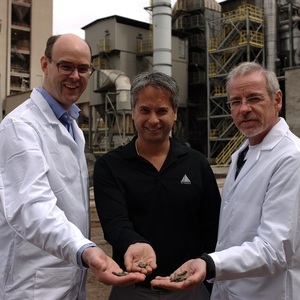Canada showcases new algae biorefinery to reduce CO2 emissions

Photo: The National Research Council of Canada
November 3, 2016
BY The National Research Council of Canada
The government of Canada is supporting clean energy research, development and technology demonstration at all stages of the innovation spectrum, from high-risk, early-stage research that can deliver transformative energy solutions, to later-stage technology demonstrations to help speed the commercialization and adoption of cleaner energy technologies.
Canada’s first algal biorefinery demonstration project, a collaborative research effort between the National Research Council of Canada’s Algal Carbon Conversion program, Pond Technologies and Votorantim Cimentos’ St Marys Cement, is revolutionizing how industrial carbon emissions are managed.
“With the assistance of NRC’s Algal Carbon Conversion program, this technology’s tremendous potential will be unleashed in real-world applications to benefit our environment and our economy,” said Roman Szumski, vice president, Life Sciences, National Research Council of Canada.
Advertisement
The project uses a 25,000-liter photobioreactor within a pilot-scale algal biorefinery to recycle carbon dioxide and other airborne industrial pollutants into algal biomass that can be further converted into sustainable products, including renewable biofuels and biomaterials. The process being deployed by NRC experts and its partners is designed to rapidly recycle carbon dioxide and other airborne industrial emissions into biomass through photosynthesis.
“Pond has developed a universal algae platform that enables the production of revenue generating algae products,” said Steven Martin, CEO and chief scientist at Pond Technologies. “We are pleased to collaborate with NRC to deploy our technology.”
Advertisement
As part of Canada’s commitment to the 21st Conference of the Parties to the United Nations Framework Convention on Climate Change (COP21), the government of Canada joined a global effort to accelerate clean energy innovation, Mission Innovation, in November 2015 and committed to double funding for clean energy and clean technology research and development by 2020.
These collaborative efforts are to reduce greenhouse gas emissions through biological conversion into algal biomass, renewable biofuels, and other value-added bioproducts. As the world transitions to a low-carbon economy, strategic investments in clean energy and emission-reducing research and development will play an increasingly important role in supporting Canada’s economic growth, in meeting its climate change objectives, while protecting the environment.
“For St Marys Cement and our parent company, Votorantim Cimentos, this collaboration with Pond Technologies and the National Research Council of Canada advances our goals of product innovation and sustainable development, while strengthening our position as a leader in the building materials sector,” said Filiberto Ruiz, president and CEO of Votorantim Cimentos, North America.
Related Stories
The USDA significantly increased its estimate for 2025-’26 soybean oil use in biofuel production in its latest World Agricultural Supply and Demand Estimates report, released July 11. The outlook for soybean production was revised down.
U.S. fuel ethanol capacity fell slightly in April, while biodiesel and renewable diesel capacity held steady, according to data released by the U.S. EIA on June 30. Feedstock consumption was down when compared to the previous month.
The U.S. EPA on July 8 hosted virtual public hearing to gather input on the agency’s recently released proposed rule to set 2026 and 2027 RFS RVOs. Members of the biofuel industry were among those to offer testimony during the event.
The USDA’s Risk Management Agency is implementing multiple changes to the Camelina pilot insurance program for the 2026 and succeeding crop years. The changes will expand coverage options and provide greater flexibility for producers.
The USDA’s National Agricultural Statistics Service on June 30 released its annual Acreage report, estimating that 83.4 million acres of soybeans have been planted in the U.S. this year, down 4% when compared to 2024.
Upcoming Events










